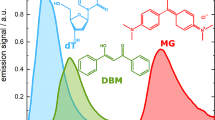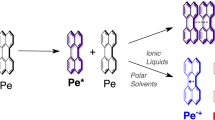An orientation factor is calculated and the effect of steric hindrance in the donor and acceptor molecules is found for the efficiency of resonance dipole–dipole transfer of electronic energy. General expressions for the acceptor luminescence anisotropy under such conditions in isotropic media (gases and liquids) are obtained taking into account orientational relaxation in ensembles of donors and acceptors. It is shown that the luminescence anisotropy of an acceptor with significant steric hindrance can increase by more than an order of magnitude compared with the case with no hindrance.
Similar content being viewed by others
References
V. L. Ermolaev, E. N. Bodunov, E. V. Sveshnikova, and T. A. Shakhverdov, Radiationless Transfer of Electronic Excitation Energy [in Russian], Nauka, Leningrad (1977).
V. A. Gaisenok and A. M. Sarzhevskii, Anisotropy of Absorption and Luminescence of Polyatomic Molecules [in Russian], Universitetskoe, Minsk (1986).
R. E. Dale, Acta Phys. Pol., A54, 743-756 (1978).
R. E. Dale, J. Eisinger, and W. E. Blumberg, Biophys. J., 26, 161–193 (1979).
C. Bojarski and J. Dudkiewicz, Chem. Phys. Lett., 67, 450–454 (1979).
J. Dudkiewicz, J. Lumin., 26, 273–280 (1982).
F. Tanaka, J. Chem. Phys., 109, 1084–1092 (1998).
J. J. Fisz, Chem. Phys., 181, 425–430 (1994).
E. I. Zenkevich, A. P. Losev, and G. P. Gurinovich, Izv. Akad. Nauk SSSR, Ser. Fiz., 36, No. 5, 979–983 (1972).
M. D. Galanin, Tr. FIAN, 5, 339–351 (1950).
R. P. Hemenger and R. M. Pearlstein, J. Chem. Phys., 59, 4064–4072 (1973).
G. L. Loper and E. K. C. Lee, J. Chem. Phys., 63, 264–271 (1975).
E. V. Dudko, Vestsi Nats. Akad. Navuk Belarusi, Ser. Fiz-Mat. Navuk, No. 5, 85–87 (2006).
R. S. Knox, Physica (Amsterdam), 39, 361–386 (1968).
E. N. Bodunov, Opt. Spektrosk., 50, 1007–1009 (1981).
D. A. Varshalovich, A. N. Moskalev, and V. K. Khersonskii, Quantum Theory of the Angular Moment [in Russian], Nauka, Leningrad (1975).
A. P. Blokhin and M. F. Gelin, Zh. Prikl. Spektrosk., 70, No 2, 196–202 (2003).
A. P. Blokhin, Vestsi Akad. Navuk BSSR, Ser. Fiz.-Mat. Navuk, No. 4, 77–86 (1986).
Author information
Authors and Affiliations
Corresponding author
Additional information
Translated from Zhurnal Prikladnoi Spektroskopii, Vol. 77, No. 1, pp. 11–17, January–February, 2010.
Rights and permissions
About this article
Cite this article
Blokhin, A.P., Tolkachev, V.A. Influence of steric hindrance on luminescence anisotropy of resonance dipole–dipole transfer of electronic excitation energy. J Appl Spectrosc 77, 6–12 (2010). https://doi.org/10.1007/s10812-010-9286-8
Received:
Published:
Issue Date:
DOI: https://doi.org/10.1007/s10812-010-9286-8




